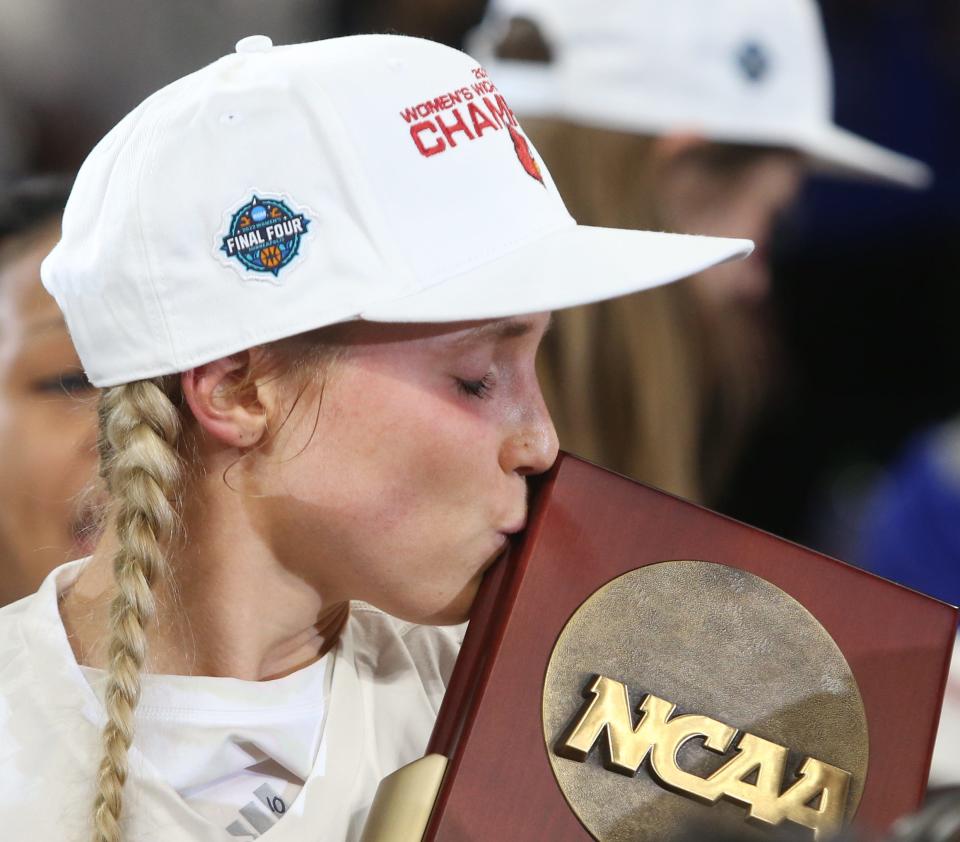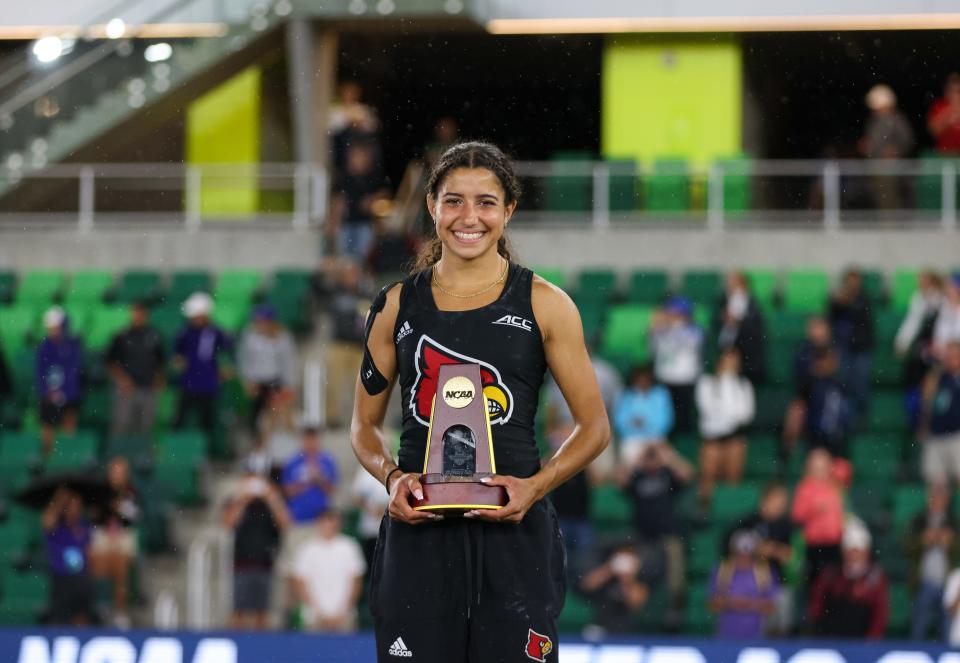Why Louisville women's programs keep on winning despite university's Title IX shortcomings
The bottom line is bifurcated. Though the University of Louisville sometimes falls short of federal Title IX guidelines, its female athletes continue to flourish.
Three different U of L women’s teams — basketball, field hockey and volleyball — all reached their respective Final Fours within the last 14 months. Last month, Louisville pole vaulter Gabriela Leon won the NCAA outdoor title. Racing Louisville selected U of L’s Emina Ekic in the first round of last year’s National Women’s Soccer League draft. Former U of L swimmer Kelsi Worrell Dahlia is an Olympic gold medalist.
“I think if we were in our position where none of our women’s teams were succeeding, or very few, then you’d have to take a hard look in the mirror: Are we walking the walk and not just talking the talk?” said Amy Calabrese, U of L’s senior women’s administrator. “I think our success with our women’s programs prove it out that we’re committed to women’s athletics.”
Fifty years since Title IX was signed into law, and sex-based discrimination was prohibited in educational programs that receive federal funding, U of L is among the vast majority of schools that struggle to comply with the law's requirements of parity in participation, treatment and athletic financial assistance. USA TODAY reported last month that 87% of the schools in the Football Bowl Subdivision did not provide athletic opportunities proportionate to their female enrollment for the 2020-21 academic year.
Keep reading: Women's rights are on the chopping block. Is Title IX also failing at age 50?
U of L's most recent report to the U.S. Department of Education said women represented 55.3% of the school’s enrollment but received only 46% of its athletic aid; that it paid the coaches of its men’s teams — assistants as well as head coaches — more than three times as much as their women’s team counterparts; and that it spent more than four times as much on recruiting male athletes as females.
A USA TODAY Title IX study found U of L spent more than 13 times as much on equipment for men’s basketball as it did for the women’s team, $327,000 versus $24,000.
Though these numbers run contrary to Title IX’s intent, they are consistent with national trends and reflect the realities of a marketplace in which gender equity remains elusive. U of L’s financial reports show the school’s men’s sports programs have generated $43 in revenue for every $1 produced by its women’s teams during the last decade. (The University of Kentucky's 2020-21 NCAA report shows a $54-to-$1 ratio in revenues that can be attributed to a specific gender)
These figures are slightly skewed because television rights to the men's and women's NCAA basketball tournaments are sold as a package and reported as men's revenue.
Closer look: Louisville women's basketball is a national powerhouse. Why doesn't the revenue match?
“I’ve always been fascinated by why do you do this?” U of L’s women’s basketball coach Jeff Walz said. “I go back to what I was told by one of our former presidents when I asked these questions. Dr. (James) Ramsey, right after we had gone to our first Final Four in ’09, he said, ‘You just spent about 12 hours on ESPN showcasing our university, our athletic department, and Louisville. The University of Louisville is plastered all over national TV. I can’t pay for that advertising.’

“I do believe because of the success of our women’s programs, that it might not all come back to you in ticket sales and revenue, but I think there’s value that you can’t necessarily put into a spreadsheet.”
Former U of L athletic director Tom Jurich told skeptics investing in women’s sports would pay benefits as the female athletes of today became the business leaders of tomorrow, and he often recounted arguments with dubious donors on that subject. Twenty-five years after Jurich’s hiring, his vision is being realized through The New Standard, a women’s sports capital campaign that has raised more than $3 million since its late September launch, including a single seven-figure contribution earmarked for new field hockey turf from a donor who declines to be identified.
Looking back: How Title IX has changed the game for women
Meanwhile, U of L’s women’s teams rank seventh nationally in the Capital One Cup, a broad-based measure of program success. That the schools tied for first, Stanford University and the University of Texas, operate with two of the nation's four largest university endowments underscores how much Louisville has done with much less.
“I think you’ve got to start with the commitment that Tom (Jurich) made,” said U of L athletic director Josh Heird, a Jurich protégé. “He added four women’s sports. When you have somebody who sets a precedent like that, the last thing you want to do is go backwards once progress has been made. . .
“Let’s look at it from a campus perspective. Think about all the resources, all the programs across the university campus that don’t create revenue. They’re providing opportunities. I think that’s one of the missions of a university, (of) higher education. And so we can’t get caught up with this generates revenue, this doesn’t. At the end of the day, it’s about are we creating opportunities?”

Recognizing enrollment trends have raised the percentage of U of L’s female students, Heird said Cardinal coaches will need to manage their rosters to achieve better overall gender balance. As of its last Department of Education report, U of L athletics claimed 350 male and 373 female participants, though runners often counted two or three times by competing in cross country, indoor and outdoor track. Excluding duplication, U of L reported 316 male and 311 female participants.
Still more work to be done: Most top colleges deprive female athletes of equal opportunities
If their funding sometimes falls short of Title IX guidelines, though, U of L women continue to win titles. Walz’s women’s basketball team reached the Final Four for a fourth time this spring. Dani Busboom Kelly’s volleyball team followed an undefeated regular season with its first Final Four appearance last December.
“I came in here as a student-athlete and from Day One, the messaging always was ‘You matter. Women’s athletics matter. You’re an athlete,’” said Calabrese, a two-time captain of U of L’s soccer team. “For 20 years, I’ve been in an environment where that is what I’m conditioned to. I grew up with that.
“I’m pretty darn proud of what we do here. I know we’re raising confident, strong, badass women. I hope they’re proud they’re Cardinals as well.”
Tim Sullivan: 502-582-4650, tsullivan@courier-journal.com; Twitter: @TimSullivan714
This article originally appeared on Louisville Courier Journal: Title IX: Louisville women athletes underfunded yet overperform peers

